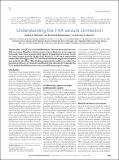Understanding the TXA seizure connection
Author(s)
Schwinn, Debra A.; Mackensen, G. Burkhard; Brown, Emery N.
DownloadBrown_Understanding the TXA.pdf (181.7Kb)
PUBLISHER_POLICY
Publisher Policy
Article is made available in accordance with the publisher's policy and may be subject to US copyright law. Please refer to the publisher's site for terms of use.
Terms of use
Metadata
Show full item recordAbstract
Transexamic acid (TXA) is an antifibrinolytic that has been used successfully to prevent blood loss during major surgery. However, as its usage has increased, there have been growing reports of postsurgical seizure events in cardiac surgery patients. In this issue of the JCI, Lecker et al. explore this connection and suggest that TXA-mediated inhibition of glycine receptors may underlie the effect. This finding prompted the authors to explore the preclinical efficacy of common anesthetics that function by reducing the TXA-mediated inhibition to prevent or modify postsurgical seizures.
Date issued
2012-11Department
Harvard University--MIT Division of Health Sciences and Technology; Massachusetts Institute of Technology. Department of Brain and Cognitive SciencesJournal
Journal of Clinical Investigation
Publisher
American Society for Clinical Investigation
Citation
Schwinn, Debra A., G. Burkhard Mackensen, and Emery N. Brown. “Understanding the TXA Seizure Connection.” J. Clin. Invest. 122, no. 12 (December 3, 2012): 4339–4341. © 2012 American Society for Clinical Investigation
Version: Final published version
ISSN
0021-9738
1558-8238